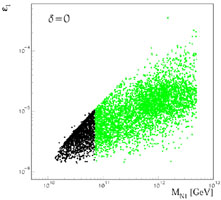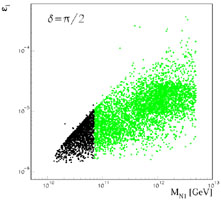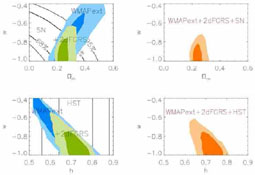


Now that we have a good idea of the matter and energy content of the Universe, and some prospects for detecting it, the next task is to calculate it from first principles on the basis of microphysics and laboratory data.

 b: As
Sakharov taught us
(Sakharov 1967),
baryogenesis
requires the violation of charge conjugation C and its combination CP with
parity, interactions that violate baryon number B, and a departure from
thermal equilibrium. The first two have been observed for quarks, and are
expected within the Standard Model. B violation is also expected in the
Standard Model, at the non-perturbative level. One might therefore wonder
whether the observed cosmological baryon asymmetry could have been
generated by the Standard Model alone, but the answer seems to be no
(Gavela et al.
1994).
However, it might be possible in the MSSM, if
it contains additional sources of CP violation beyond the Standard Model
(Carena et al.
2003).
An attractive alternative is leptogenesis
(Fukugita & Yanagida
1986),
according to which first the decays of heavy
singlet neutrinos create a CP-violating asymmetry
b: As
Sakharov taught us
(Sakharov 1967),
baryogenesis
requires the violation of charge conjugation C and its combination CP with
parity, interactions that violate baryon number B, and a departure from
thermal equilibrium. The first two have been observed for quarks, and are
expected within the Standard Model. B violation is also expected in the
Standard Model, at the non-perturbative level. One might therefore wonder
whether the observed cosmological baryon asymmetry could have been
generated by the Standard Model alone, but the answer seems to be no
(Gavela et al.
1994).
However, it might be possible in the MSSM, if
it contains additional sources of CP violation beyond the Standard Model
(Carena et al.
2003).
An attractive alternative is leptogenesis
(Fukugita & Yanagida
1986),
according to which first the decays of heavy
singlet neutrinos create a CP-violating asymmetry
 L
L
 0, and
then this is partially converted into a baryon asymmetry by
non-perturbative weak interactions.
0, and
then this is partially converted into a baryon asymmetry by
non-perturbative weak interactions.
At the one-loop level, the asymmetry in the decays of one heavy singlet neutrino Ni due to exchanges of another one, Nj, is
 |
(3.1) |
where Y is a
matrix of Yukawa couplings between heavy singlet and
light doublet neutrinos. The expression (3.1) involves a sum
over the light leptons, and hence is independent of the CP-violating MNS
phase
is a
matrix of Yukawa couplings between heavy singlet and
light doublet neutrinos. The expression (3.1) involves a sum
over the light leptons, and hence is independent of the CP-violating MNS
phase  and the Majorana
phases
and the Majorana
phases
 1,2.
Instead, it is controlled by extra phase parameters that are not
directly accessible to low-energy experiments.
1,2.
Instead, it is controlled by extra phase parameters that are not
directly accessible to low-energy experiments.
This leptogenesis scenario produces effortlessly a baryon-to-photon ratio
YB of the right order of magnitude. However, as seen in
Fig. 13, the CP-violating decay asymmetry (3.1) is
explicitly independent of  (Ellis & Raidal 2002).
On the other
hand, other observables such as the charged-lepton-flavour-violating
decays µ
(Ellis & Raidal 2002).
On the other
hand, other observables such as the charged-lepton-flavour-violating
decays µ  e
e  and
and 
 µ
µ
 may cast
some indirect light on the mechanism of leptogenesis
(Ellis et al. 2002a,
b).
Predictions for these decays may be refined if one makes extra hypotheses.
may cast
some indirect light on the mechanism of leptogenesis
(Ellis et al. 2002a,
b).
Predictions for these decays may be refined if one makes extra hypotheses.
 |
 |
Figure 13. Comparison of the CP-violating asymmetries in the decays of heavy singlet neutrinos giving rise to the cosmological baryon asymmetry via leptogenesis (left panel) without and (right panel) with maximal CP violation in neutrino oscillations (Ellis & Raidal 2002). They are indistinguishable. |
|
One possibility is that the inflaton might be a heavy singlet sneutrino
(Murayama et al.
1993,
1994).
This would require a mass
 2 ×
1013 GeV, which is well within the range favoured by seesaw
models. The sneutrino inflaton model predicts
(Ellis et al. 2003b)
values of the spectral index of scalar perturbations, the fraction of
tensor perturbations and other CMB observables that are consistent with
the WMAP data
(Peiris et al.
2003).
Moreover, this model predicts a branching ratio for
µ
2 ×
1013 GeV, which is well within the range favoured by seesaw
models. The sneutrino inflaton model predicts
(Ellis et al. 2003b)
values of the spectral index of scalar perturbations, the fraction of
tensor perturbations and other CMB observables that are consistent with
the WMAP data
(Peiris et al.
2003).
Moreover, this model predicts a branching ratio for
µ  e
e
 within a
couple of orders of magnitude of the present experimental upper limit.
within a
couple of orders of magnitude of the present experimental upper limit.

 CDM: The
relic density of supersymmetric dark matter
is calculable in terms of supersymmetric particle masses and Standard
Model parameters. The sensitivity to these parameters is quite small in
generic regions, but may be larger in some exceptional regions
corresponding to `tails' of the MSSM parameter space
(Ellis & Olive 2001).
At least away from these regions, data from the LHC on
supersymmetric parameters should enable the cold dark matter density to be
calculated quite reliably.
CDM: The
relic density of supersymmetric dark matter
is calculable in terms of supersymmetric particle masses and Standard
Model parameters. The sensitivity to these parameters is quite small in
generic regions, but may be larger in some exceptional regions
corresponding to `tails' of the MSSM parameter space
(Ellis & Olive 2001).
At least away from these regions, data from the LHC on
supersymmetric parameters should enable the cold dark matter density to be
calculated quite reliably.


 :
The biggest challenge may be the cosmological
vacuum energy. For a long time, theorists tried to find reasons why the
cosmological constant should vanish, but no convincing symmetry to
guarantee this was ever found. Now cosmologists tell us that the vacuum
energy actually does not vanish. Perhaps theorists' previous failure
should be reinterpreted as a success? If the vacuum energy is indeed a
constant, the hope is that it could be calculated from first principles in
string or M theory. Alternatively, as argued here by
Steinhardt 2003,
perhaps the vacuum energy is presently relaxing towards zero, as in
quintessence models
(Maor et al. 2002).
Such models are getting to
be quite strongly constrained by the cosmological data, in particular
those from high-redshift supernovae and WMAP
(Spergel et al.
2003)
as seen in Fig. 14, and it seems that the
quintessence equation of state must be quite similar to that of a true
cosmological constant
(Spergel et al.
2003).
Either way, the vacuum energy is a
fascinating discovery that provides an exciting new opportunity for
theoretical physics.
:
The biggest challenge may be the cosmological
vacuum energy. For a long time, theorists tried to find reasons why the
cosmological constant should vanish, but no convincing symmetry to
guarantee this was ever found. Now cosmologists tell us that the vacuum
energy actually does not vanish. Perhaps theorists' previous failure
should be reinterpreted as a success? If the vacuum energy is indeed a
constant, the hope is that it could be calculated from first principles in
string or M theory. Alternatively, as argued here by
Steinhardt 2003,
perhaps the vacuum energy is presently relaxing towards zero, as in
quintessence models
(Maor et al. 2002).
Such models are getting to
be quite strongly constrained by the cosmological data, in particular
those from high-redshift supernovae and WMAP
(Spergel et al.
2003)
as seen in Fig. 14, and it seems that the
quintessence equation of state must be quite similar to that of a true
cosmological constant
(Spergel et al.
2003).
Either way, the vacuum energy is a
fascinating discovery that provides an exciting new opportunity for
theoretical physics.
 |
Figure 14. Constraints on the equation of state of the dark energy from WMAP and other CMB data (WMAPext) combined with data on high-redshift supernovae, from the 2dF galaxy redshift survey and from the Hubble Space Telescope (Spergel et al. 2003). |